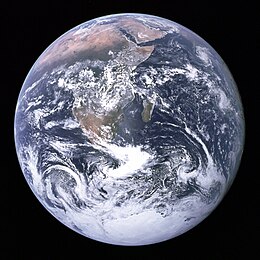
The Blue Marble photograph of Earth, taken during the Apollo 17 lunar mission in 1972 |
| Orbital characteristics |
| Epoch J2000 |
| Aphelion |
152,100,000 km (94,500,000 mi)
(7011152100643076810♠1.01673 AU)  |
| Perihelion |
147,095,000 km (91,401,000 mi)
(7011147094903845957♠0.9832687 AU)  |
|
Semi-major axis |
149,598,023 km (92,955,902 mi)
(7011149598022990632♠1.000001018 AU)  |
| Eccentricity |
6998167086000000000â™ 0.0167086 |
|
Orbital period |
7007315581497635456♠365.256363004 d 
(7000100001742095999â™ 1.00001742096 yr) |
|
Average orbital speed |
29.78 km/s (18.50 mi/s)
(107,200 km/h (66,600 mph)) |
|
Mean anomaly |
7002358617000000000♠358.617° |
| Inclination |
|
|
Longitude of ascending node |
2998887393600000000♠−11.26064° to J2000 ecliptic |
|
Argument of perihelion |
7002114207830000000♠114.20783° |
| Satellites |
|
| Physical characteristics |
|
Mean radius |
6,371.0 km (3,958.8 mi) |
|
Equatorial radius |
6,378.1 km (3,963.2 mi) |
|
Polar radius |
6,356.8 km (3,949.9 mi) |
| Flattening |
6997335280000000000â™ 0.0033528
1/298.257222101 (ETRS89) |
| Circumference |
|
|
Surface area |
- 510,072,000 km2 (196,940,000 sq mi)
- 148,940,000 km2 (57,510,000 sq mi) (29.2%) land
- 361,132,000 km2 (139,434,000 sq mi) (70.8%) water
|
| Volume |
7021108320999999999♠1.08321×1012 km3 (7011259876000000000♠2.59876×1011 cu mi) |
| Mass |
7024597237000000000♠5.97237×1024 kg (7024597236001731600♠1.31668×1025 lb)
(7024596565000000000♠3.0×10−6 M☉) |
|
Mean density |
5.514 g/cm3 (0.1992 lb/cu in) |
|
Surface gravity |
9.807 m/s2 (32.18 ft/s2)
(7000100000000000000â™ 1 g) |
|
Moment of inertia factor |
0.3307 |
|
Escape velocity |
11.186 km/s (6.951 mi/s) |
|
Sidereal rotation period |
7004861641003520000â™ 0.99726968 d
(23h 56m 4.100s) |
|
Equatorial rotation velocity |
1,674.4 km/h (1,040.4 mph) |
|
Axial tilt |
23.4392811° |
| Albedo |
|
| Surface temp. |
min |
mean |
max |
| Kelvin |
184 K |
288 K |
330 K |
| Celsius |
−89.2 °C |
15 °C |
56.7 °C |
| Fahrenheit |
−128.5 °F |
59 °F |
134 °F | |
| Atmosphere |
|
Surface pressure |
7005101325000000000â™ 101.325 kPa (at MSL) |
| Composition by volume |
|